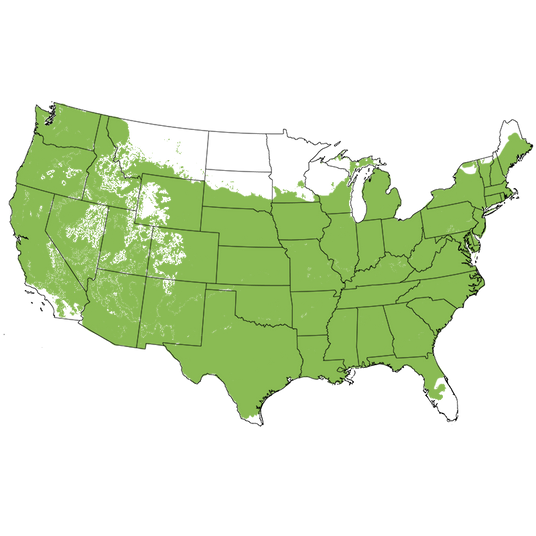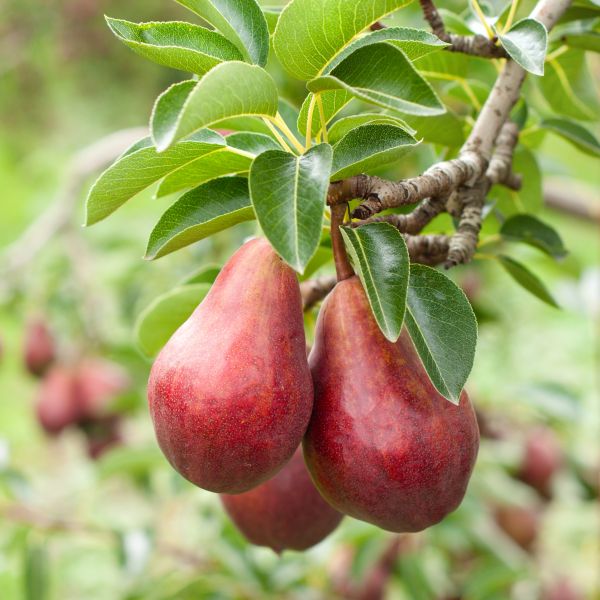Red Bartlett Pear Tree
Pyrus 'Red Bartlett'
Plant Sentry™
Plant Sentry™

Plant Sentry™ Protected
Your order is protected by our compliance system that:
- Prevents restricted plants from shipping to your state
- Ensures plants meet your state's agricultural requirements
- Protects gardens from invasive pests and diseases
Delivery and Shipping
Delivery and Shipping
Delivery and Shipping
Fast, Safe Plant Delivery
Ships in 3-4 business days • Tracking provided • Weather protected
| Under $50 | $9.99 |
| $50 - $99.99 | $14.99 |
| $100 - $149.99 | $16.99 |
| $150 - $198.99 | $24.99 |
| $199+ | FREE |
✓ Zone-specific timing • ✓ Professional packaging • ✓ Health guarantee
Understanding Plant Options
Nature Hills offers plants in two main formats:
- Container Plants: Grown in pots with soil, sized by container volume and plant age
- Bare Root Plants: Dormant plants without soil, sized by height measurements
Container Plant Sizes
Container sizes indicate plant age and growing capacity rather than liquid volume equivalents. Our containers follow industry-standard nursery "trade gallon" specifications, which differ from standard liquid gallon measurements.
Young Plants (6 months to 18 months old)
| Container Size | Actual Volume | Metric Equivalent |
|---|---|---|
| 2" x 2" x 3" | 0.18 - 0.21 dry quarts | 0.20 - 0.23 dry liters |
| 4" Container | 0.31 - 0.87 dry quarts | 0.35 - 0.96 dry liters |
| 4.5" Container | 0.65 dry quarts | 0.72 dry liters |
| 6" Container | 1.4 dry quarts | 1.59 dry liters |
| 1 Quart | 1 dry quart | 1.1 dry liters |
| 5.5" Container | 1.89 dry quarts | 2.08 dry liters |
Established Plants (18 months to 2.5 years old)
| Container Size | Actual Volume | Metric Equivalent |
|---|---|---|
| 2 Quart | 2 dry quarts | 2.2 dry liters |
| #1 Container | 2.26 - 3.73 dry quarts | 2.49 - 4.11 dry liters |
| 5" x 5" x 12" | 3.5 - 4.3 dry quarts | 3.85 - 4.74 dry liters |
Mature Plants (2-4 years old)
| Container Size | Actual Volume | Metric Equivalent |
|---|---|---|
| #2 Container | 1.19 - 1.76 dry gallons | 5.24 - 7.75 dry liters |
| #3 Container | 2.15 - 2.76 dry gallons | 8.14 - 12.16 dry liters |
Large Plants (3-5 years old)
| Container Size | Actual Volume | Metric Equivalent |
|---|---|---|
| #5 Container | 2.92 - 4.62 dry gallons | 12.86 - 20.35 dry liters |
| #6 Container | 5.25 - 6.01 dry gallons | 23.12 - 26.42 dry liters |
| #7 Container | 5.98 - 6.53 dry gallons | 26.34 - 28.76 dry liters |
Bare Root Plants
Bare root plants are sold by height from the root system to the top of the plant. Plants may exceed minimum height requirements.
Common Sizes:
- Trees: 1 foot, 2 feet, 3 feet, 4 feet, 5 feet, 6 feet
- Shrubs & Perennials: 1 foot, 18 inches, 2 feet
Important Notes
Container Volume Specifications
- Trade Gallon Standard: Our containers follow industry-standard "trade gallon" specifications established by the American National Standards Institute (ANSI Z60.1) for nursery stock
- Volume Variations: Actual soil volume may vary due to plant root systems and growing medium settlement
- Age Indicators: Container size primarily indicates plant age and maturity rather than liquid volume equivalents
Growing Conditions
- Plant size can vary based on variety and growing conditions
- Container size helps indicate plant maturity and establishment level
- Larger containers generally mean more established root systems and faster landscape establishment
Seasonal Availability
- Bare root plants are available seasonally when dormant
- Container plants are available throughout the growing season
- Specific varieties may have limited availability in certain sizes
Questions?
For questions about specific plant sizes or availability, please contact our plant experts who can help you choose the right size for your landscape needs.

Plant Sentry™ Protected
Your order is protected by our compliance system that:
- Prevents restricted plants from shipping to your state
- Ensures plants meet your state's agricultural requirements
- Protects gardens from invasive pests and diseases
Plant Profile & Growing Essentials
Cold hardy, Self-pollinating, Flowering, Edible, Ornamental Berries/Fruit, Attracts pollinators, and Thornless
Specifications
Specifications
-
Botanical Name
-
Height
-
Width
-
Growing Zones
-
Sunlight
-
Growth RateModerate
-
Flower Color
-
Leaf Color
-
Pollinator FriendlyYes
-
Pollinator Required
-
Bloom PeriodLate Spring
-
Harvest Time
-
FragrantYes
Planting & Care Instructions
Planting & Care Instructions

Growing Zones 5-9
Delicious, Reliable Red Bartlett Pear Tree
- Mid-Season
- Beautiful Springtime Flower Display
- Features Bright Red Color
- Sweet, Crisp Flesh
- Enjoy Fresh From the Tree, No Need to Wait
- Great Canning Variety
- Fruit Stores for Three Months
- Gorgeous Fruit Tree
- Cross Pollinated With Another Pear Variety
- Great for Beginners
- Extremely Cold Hardy
- Urban Tolerant
For an elevated eating experience, try red-skinned Red Bartlett Pear (Pyrus 'Red Bartlett'). Grow Pear trees in your own space to enjoy the luscious taste of homegrown fruit. The Red Bartlett, known also as 'Max Red', was first discovered as a bud sport on a Yellow Bartlett tree in 1938.
Unlike other European Pear varieties, Red Bartlett fully ripens on the tree. These beautiful, highly pigmented pears are amazingly plucked and enjoyed, still warm from the sun.
They are incomparable as a fresh-eating pear. The exceptional flesh is juicy, sweet, and redolent of the world-famous Bartlett. These deciduous trees have several ornamental features. You'll thrill each spring to the profuse floral display of white blooms.
Young, bell-shaped fruit develops with dark red stripes that brighten to clear red as they mature. They are beautiful to look at, and their fruity-floral aroma adds to the enjoyment. Eat them fresh, or can them for use later in the year.
Best of all, this vigorous tree is hardy and long-lived. Beginners should take a good look at this variety. These gorgeous pears taste best fresh from your backyard orchard. Order your Red Bartlett Pear trees today.
How to Use Red Bartlett Pear Tree in the Landscape
Red Bartlett Pear trees are versatile, growing well in agricultural, suburban and urban environments. Urban pollution doesn't seem to be a problem for this amazing fruit tree. It's easy to keep fruit trees pruned to any size. All you need to do is spend a few minutes in summer tip pruning back to the height you want. Smaller fruit trees are easier to net and harvest.
Try them in a high-density planting with other varieties to cross-pollinate. Include other European Pears, or try a super-juicy, crisp Asian Pear tree. Create a hard-working hedgerow along your fence by planting 7 feet apart on center. You'll measure from the trunk of one to the trunk of the next. Join the Edible Landscape trend and reap the rewards with easy-care fruiting trees like Red Bartlett. You can't go wrong with this classic.
Red Bartletts are the beauty queens of the pear world. You'll think of a million ways to use this healthy fruit. Try them in salads, slaws, sauces, crisps, chutneys and preserves. They make a wonderful presentation on dessert plates.
#ProPlantTips for Care
Plant Pear trees in full sun for best results. They need at least 6 hours of direct sunlight a day. You will also want a spot that has good air circulation. Avoid low-lying, frost-trapping planting sites that might harm the spring blooms. They prefer well-drained soil types, and won't tolerate standing water. Plant in a raised bed or mounded planting site to improve drainage, if needed.
Give a moderate amount of water on a regular basis. Apply a thick layer of mulch over the root system and spread it out to 3 feet past the canopy. Pull mulch back several inches all around the trunk for air circulation.
Tip prune to control size in the summertime. Our experts say to "Choose a size, and keep it there." Remove crossing or broken branches any time of year. Sculpt scaffolding branches to 45-degree angles in late winter.
Boost the quality of your food with homegrown fruit. As you can imagine, foodies and homeowners across the country are searching for these popular trees.
Hurry, order Red Bartlett Pear trees from Nature Hills. Their sell-out risk is high!
Red Bartlett Pear Tree Frequently Asked Questions
How long does it take for Red Bartlett Pear Trees to bear fruit?
Nature Hills Nursery sells fruit trees with mature root systems, and will often set fruit in their second or third years.
How Fast Do Red Bartlett Pear Trees Grow?
Pear trees are moderate growth rate plants and can add 12-18 inches and more per year in optimal conditions once they have established.
Where do Red Bartlett Pear Trees Grow Best?
Pear trees grow best in well-drained, fertile soil in at least 6 hours of full sun per day or more.
Do You Need 2 Pear Trees to Produce Fruit?
All Pyrus varieties have different requirements to set fruit. While a few varieties are self-fertile, you will always have a larger harvest with a pollination partner. Red Bartlett pollinating partners include:
- Beurre Bosc
- Blake's Pride
- Brandy
- Flemish Beauty
- Harrow Crisp
- Korean Giant
- Moonglow
- Potomac
- Red Clapp's Favorite
- Shenandoah
- Shinsui
- Yellow Huffcap
No room? Look into High-Density Planting techniques, or choose a semi-dwarf or dwarf fruit tree.
When Should Red Bartlett Pear Trees be Planted?
Bareroot Pear trees are best planted in the spring but container-grown Pear trees can be successfully transplanted all throughout the growing season as long as the ground isn't frozen and they are carefully watered as needed. Check for the first and last frost dates for your area with your local County Extension Office.
Harvest Times for Red Bartlett Pears
Red Bartlett pears are typically ready to harvest in late August or early September.
How Do I Find Red Bartlett Pear Trees for Sale Near Me?
Make your life easier and your yard happier by shopping for Pear trees at NatureHills.com online fruit tree nursery. You'll find a massive selection of fruit trees for sale, including many lovely Pear tree varieties!
Choose the right tree for your area by first finding your growing zone by entering your zip code in the field above the Plant Highlights section on our product pages. Narrow down your options by plant hardiness zone, sun availability, and size requirements.
Place your order, knowing it's backed by the Nature Hills Nursery product guarantee and protected by Plant Sentry™, which helps ensure regulated plant materials aren’t sent to prohibited areas.
Expect to receive your plants at the appropriate planting time for your growing zone when temperatures are safest.








